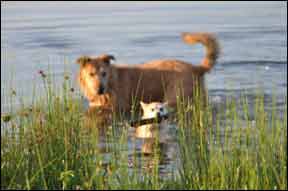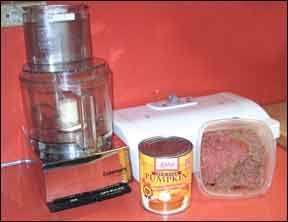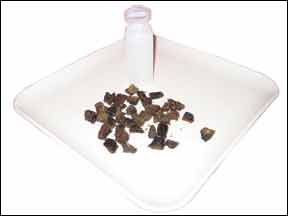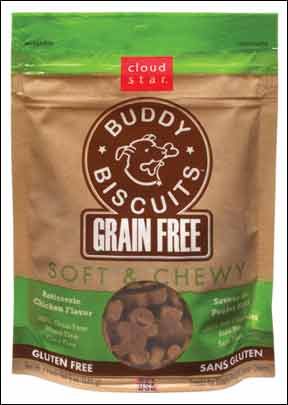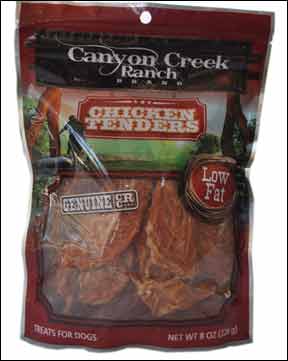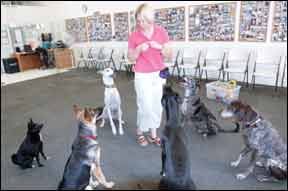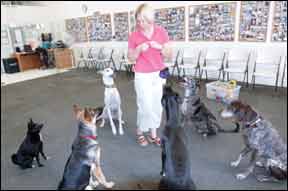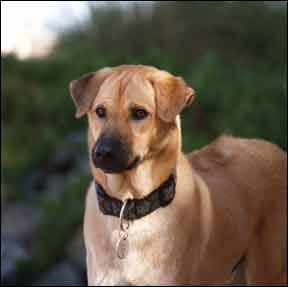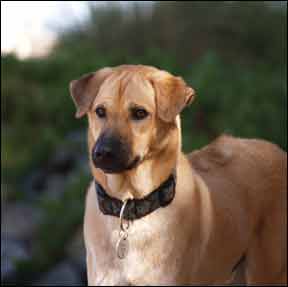Several raw feeders contacted me after reading my homemade diet guidelines (“You Can Make It”) in July’s Whole Dog Journal issue. While their diets varied considerably, each had problems that are common with raw diets – but most are easily fixed.
For example, many raw diets are high in bone, which provides calcium and phosphorus. Excess calcium can lead to serious orthopedic conditions in large-breed puppies, especially before puberty. High-calcium diets are not dangerous for adult dogs, but calcium binds other minerals, including zinc and iron, so a diet high in bone may lead to other nutritional deficiencies. Too much bone can also cause constipation.
Most raw diets are high in fat, particularly those that use high-fat meats or include skin from poultry. High-fat diets can be appropriate for very active or working dogs, but too much fat can cause digestive upset and even pancreatitis in susceptible dogs. High-fat diets can also lead to obesity, or be nutritionally deficient when portion sizes are limited in order to avoid feeding too many calories.
Raw diets that are not supplemented will be low in vitamin E. Other nutrients may also be inadequate, particularly in diets that are missing or low in red meat, poultry, fish, or vegetables, and those that are high in fat.
Raw feeders wonder why this is true, since wolves don’t eat vegetables or take supplements, but we can’t really duplicate the evolutionary diet of the wolf, nor is it necessarily the best diet for our dogs. Wolves travel many miles every day, so a higher fat diet is more appropriate for them than for our more sedentary pets. Wolves eat whole large prey, including things like blood, brains, eyeballs, and a variety of glands that we don’t feed, so we have to replace those nutrients with other foods. Nature is concerned only with procreation, not with longevity. The antioxidants and phytonutrients found in fruits and vegetables may help our dogs to live longer and healthier lives.
How Much Bone?
I recommend feeding 30 to 50 percent raw meaty bones, using the higher amount only if the parts fed are very meaty. The rest of the diet should consist of boneless meat, organs, fish, eggs, dairy, vegetables, fruits, and grains (optional).
Lori Lockyear, who lives in Michigan, has two dogs: Wilson, a 5 ½-year-old, 34-pound Labradoodle, and Woody, a 4-year-old, 40-pound Goldendoodle. She feeds them a combination of half kibble (Orijen 6 Fish) and half raw. The raw portion of the diet consists primarily of raw meaty bones, including ground chicken and turkey mixes that contain meat, skin, bones, and organs. She also feeds whole chicken thighs and backs (with skin and separable fat removed), beef ribs, and Nature’s Variety Instinct Raw Frozen Diet (lamb variety), and adds vegetables, either leafy green or starchy (sweet potatoes or pumpkin), plus low-fat yogurt and egg yolks. She supplements with fish oil.
Because most of the raw half of the diet that Lockyear feeds is comprised of raw meaty bones, her diet is high in calcium. Chicken thighs are a better choice than backs, since they have more meat. She should replace some of the ground mixtures with lean, boneless meat, preferably red meat, since the diet is high in poultry. Beef heart would be an inexpensive choice, and she could also include a small amount of beef liver. Low-fat dairy can also be used; it has some calcium, but not nearly as much as bone.
Wendy Mayer, who lives in Alberta, Canada, feeds her three Golden Retrievers a diet based on Dr. Becker’s Real Food for Healthy Dogs & Cats, by Beth Taylor and Karen Becker, DVM. Instead of boneless meat, however, two-thirds of the meat she uses is a ground product that includes bone. This product claims to be made from whole animal carcasses, but the varieties she uses (elk and bison) are high in calcium, over 1 percent as fed, which converts to over 3.7 percent on a dry matter basis (DM). The maximum amount of calcium allowed by the canine nutrient guidelines compiled by the Association of American Feed Control Officials (AAFCO) is 2.5 percent DM.
Because Mayer feeds boneless meat one-third of the time, one way to reduce the total amount of calcium in the diet is to not add calcium when she feeds boneless meat. This will lower the overall percentage of calcium in the diet to within AAFCO guidelines.
How Much Fat?
It’s best to use meats that are 10 percent fat or less, which is comparable to about 30 to 40 percent fat in kibble, since fresh foods are high in moisture. Most commercial raw blends are higher in fat than this, particularly if you consider that they often include organs and vegetables that should reduce the overall amount of fat.
Lockyear’s diet is high in fat, since the mixes she uses contain skin, and Nature’s Variety Instinct, like most commercial raw foods, is high in fat. Replacing some of these with lean, boneless meat and low-fat dairy will reduce the amount of fat as well as calcium in the diet. The two egg yolks fed to each dog should be replaced with one whole egg. Although Lockyear relies on the commercial part of the diet to provide fish, she could consider feeding one meal a week of canned fish with bones (sardines packed in water, jack mackerel, or pink salmon), which are lower in fat than the mixes she uses.
Karen Murad, a Washington resident, is an AKC Breeder of Merit of Papillons. She feeds a raw diet to some of her dogs, making large batches that include 4 pounds of boneless meat, 1 pound chicken necks, 1 pound organ mix, 2 eggs, ½ cup mashed vegetables, and a variety of whole food supplements, including NOW Bone Meal Powder, since her diet is low in bone.
Murad’s diet is almost 50 percent fat on a dry matter basis, partly because half the boneless meat she uses is high-fat ground beef (the other half is skinless chicken thighs, which are fine). At least half of the ground beef should be replaced with lower-fat meat, such as 90 percent lean ground beef, beef heart, canned fish, or additional chicken.
Murad also adds 3 tablespoons each of olive oil and coconut oil, neither of which are needed. All oils provide 4.5 grams of fat and 40 calories per teaspoon, which add up fast. The added oils should be eliminated or greatly reduced. I’d prefer to see her feed more eggs instead of so much oil, since the eggs have more nutritional value.
Keep in mind that when fat is decreased, the amount fed must be increased to maintain the same number of calories.
Supplements
All raw diets need added vitamin E. I recommend giving 1 to 2 IUs per pound of body weight daily (larger amounts can be given less often). Murad could add one 200 IU gelcap of vitamin E to her recipe to provide all the vitamin E that her dogs need. Lockyear’s dogs get most of the vitamin E they need from the commercial portion of their diet, so giving each dog 200 IUs once a week would be ample.
If kelp is used to provide iodine, make sure the amount is appropriate. Murad was adding 1 tablespoon NOW Kelp Powder to her recipe, which turned out to provide almost 10 times the amount of iodine that her dogs needed. Too much iodine can suppress thyroid function, and kelp is also a source of arsenic, so best to keep amounts small.
Murad supplements with cod liver oil, which is preferable to fish oil in her case because her recipe does not include fish. (Another option would be to include one 15-ounce can of fish with bone in her recipe). One tablespoon of cod liver oil added to the recipe will provide appropriate amounts of vitamin D and omega-3 fatty acids (make sure it includes vitamin D, which is removed from molecularly distilled products). Lockyear gives each of her dogs 1 gram of fish oil daily, which is a good idea, since omega-3 fatty acids likely don’t survive well in kibble.
After cutting the amount of fat in her recipe almost in half (by eliminating the unneeded oils and reducing the amount of high-fat beef), Murad should increase the amount she feeds by about one-third, so as to provide equivalent calories. This also increases all nutrient levels to adequate levels (with added vitamin E and cod liver oil).
Mary Straus is the owner of DogAware.com. She lives with her Norwich Terrier, Ella, in the San Francisco Bay Area.



